5. Feel the Rind—Not Too Thick or Too Soft
The ideal rind is firm with a slight give and relatively thin.
Why this works: A thinner rind means more space for sweet, juicy flesh. An overly thick rind often points to a tougher, less flavorful melon.
Check it: Run your hand over the surface. It should be smooth with a consistent texture—no soft or spongy spots.
6. Steer Clear of Damage
Choose a watermelon that’s free from dents, cracks, bruises, or mold.
Good signs:
A slight shine on the rind (not dull)
Smooth, unbroken skin
A symmetrical shape (no lumps or flattened sides)
For pre-cut watermelon: The flesh should look moist and glossy—not dry or stringy.
Bonus Tip: Vine Test (for Farm or Market Picks)
If you’re selecting from a vine or local stand, check the curly tendril near where the melon was attached. A brown, dry tendril signals ripeness. If it’s still green, the melon may have been picked prematurely.
The Watermelon Checklist:

